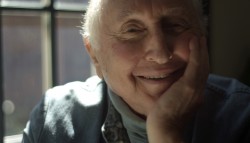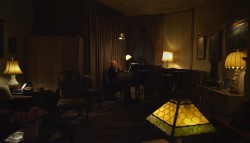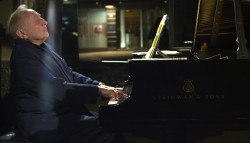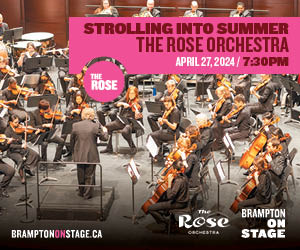“Music is a reminder of our own potential for perfection.”
-- Seymour Bernstein
In last September’s issue of The WholeNote, in my preview of the Toronto International Film Festival, I wrote that the film I was most looking forward to was Ethan Hawke’s Seymour: An Introduction. It had been Hawke’s explanation of Bernstein’s teaching mantra (responding to Hubert Vigilia’s question on flixist.com, two years ago just as the film was taking shape) that piqued my curiosity and made the film a must on my TIFF to-do list.
Said Hawke: “He’s a very deep guy. I was touched by him, and I thought he had a lot to teach me about acting, and then I slowly realized that the way he’s talking about the piano relates to every profession.”
I was touched, charmed and inspired by Hawke’s moving documentary when I saw it at TIFF and couldn’t wait to see it again. Six months later, it’s begun an exclusive engagement at the Cineplex Varsity Cinemas. The second time I was even more moved. Be prepared to be charmed and inspired when you see it. It’s unmissable.
Hawke (Boyhood, Before Sunrise, Before Sunset, Before Midnight) has given us a tender, warm portrait of the captivating pianist Seymour Bernstein. Among many things Hawke’s documentary does, it debunks the axiom that those who can, do and those who can’t, teach. And it does so with wall-to-wall piano music highlighted by Bernstein’s own playing of Chopin (Berceuse, Ballade No.1, Nocturne Op.37 No.2) and Beethoven (Bagatelles Op.126, Sonata Op.111, “Moonlight” Sonata) among others, as well as some of his own compositions.
Hawke, at 40, was struggling with why he does what he does as an actor. At a dinner organized by Bernstein’s former student Tony Zito, Hawke felt more comfortable around the 84-year-old Bernstein than anyone else. He seized on their rapport as the impetus to document the older man’s teachings.
A good place to start was with The New York Times’ culture reporter Michael Kimmelman, who had begun lessons with Bernstein at five. Kimmelman’s mother, who used to sit sketching during his lessons in Bernstein’s apartment, presented the teacher with a sculpture of his cat. Years later, Kimmelman repaid his teacher by annotating a 2-CD set of Bernstein’s live concert career.
Bernstein himself had begged his mother for piano lessons when he was six despite the lack of music in his home. A sensitive soul even then, Scarlatti felt familiar to him and he cried over Schubert’s Serenade (we hear snippets of each). When he was 15 he realized that the “real essence of who we are resides in our talent.” If he was practising well, things in general went well: “Music and life will interact in a neverending cycle of fulfillment.”
He had a patroness, a wealthy woman who was also a spiritualist, who sponsored his European concerts and provided one of her houses for him to live in. Which he did for a year, before the almost daily gifts that were delivered convinced him to give it all up. She was growing too enamoured of him.
Then, at 50, in 1977, Bernstein gave a farewell concert at the 92nd Street Y, yielding to “nerves.” Public performance terrified him; he had terrible blocks, physical symptoms, memory lapses, a feeling of inadequacy as a pianist: “If you feel inadequate as a musician then you’ll feel inadequate as a person.” Yet he tells Hawke that most artists should be more nervous. He recounts a story about a young actress who was surprised to find the great Sarah Bernhardt in a state backstage. When she told Bernhardt that she never suffered before a performance, Bernhardt replied: “You will get nervous when you learn how to act.”
Bernstein rebuilt his own self worth by teaching and workshopping – he’s currently on the faculty of NYU’s Steinhardt School of Culture, Education and Human Development. He found his creative identity as a teacher. “I poured it into you,” he tells Kimmelman.
At an NYU master class he demonstrates how the impetus for an entire sonata (Beethoven’s Op.110) develops out of the first four bars; the sound he creates on the keyboard seems to grow, not die (as the student’s did). “Don’t move in a way that the energy is pulled away from the piano,” he advises another. The key is “to inspire and encourage an emotional response, not just for music but for all aspects of life.”
He thrives on solitude; he’s lived for 57 years in the same apartment [by now it must be 60]; Hawke shows him making up his sofa bed one morning before breakfast while he sorts out all the thoughts that course through him. He finds the sense of predictability of music something he can control, as opposed to the world outside: “Avoid excess analysis and allow the music to reveal its own beauty.”
He studied with such storied musicians as Alexander Brailowsky, Sir Clifford Curzon, Jan Gorbaty, Nadia Boulanger and Georges Enescu. Curzon, his most significant mentor, always his hero and the model of “what you should be,” once told him that the most important thing about choosing a piano is “how softly the piano will play.”
There is wonderful vintage footage of Curzon playing Schubert’s Impromptu Op.90 No.4 in the basement of Steinway Hall. The basement has its own role in the film as Bernstein searches out a suitable piano for the recital Hawke will film in the Steinway rotunda before an invited audience of (mostly) the actor/director’s friends and colleagues. Watching Bernstein’s delight in finding a piano that responds to his playing of the opening of Beethoven’s Piano Concerto No.4 is another of the countless musical treasures of this film.
Spiritual teacher Andrew Harvey, one of the key talking heads Hawke turns to, notes Bernstein’s integration of the ordinary and the archetypal. “The key is that music can produce ecstasy and you [Bernstein] have the touchstone from which you can gauge everything else.” (Bernstein believes – much like Marc-André Hamelin – that a performer gets closer to the creative process when he plays, if he also composes.)
The film’s aesthetic and narrative climax is the recital in the Steinway Hall rotunda. Here, Hawke gives his artistic sense full flower by seamlessly cutting back and forth from Bernstein playing Schumann’s Fantasie Op.17 in his apartment to performing it in the rotunda recital. What makes it so compelling is Bernstein’s description of how he feels about the piece while playing it in his living room: it “just rips him apart, it’s just so impossibly beautiful; it has one of the biggest climaxes in all music (here it comes).” As he finishes each comment, Hawke cuts to the recital and the Fantasie continues without pause.
For me, the most hypnotic moment of this sublimely hypnotic film is Bernstein’s playing of Brahms’ Intermezzo Op.118 No.2, which occupies the left half of the screen as the closing credits roll on the right. Brahms marks the score Andante Teneramente and Bernstein plays it with a tenderness that envelops the lyricism he coaxes out of the music. His last words in the film “I never dreamt with my own two hands that I could touch the sky” are, in that moment, absolutely believable.
This unmissable film began its exclusive engagement March 20 at the Varsity Cinemas.






